In what ways does your media product use, develop or challenge forms and conventions of real media products?
My media product both uses and challenges the forms and conventions of real media products.
Use
In order for my product to be identifiable as a slasher it must follow some of the codes and conventions of the sub-genre (especially considering that the slasher sub-genre is a good example of genre purism and has not changed much over time).
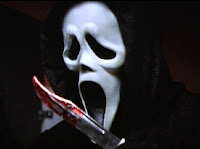 The first convention I used was to have a masked killer who is armed with a knife. I chose to do this because I feel it is still an effective combination when trying to create fear and also as a homage to scream which contains my favourite slasher opening sequence. I feel I have used this convention effectively and created a character that can genuinely scare people and which also adds an authentic touch to my production.
The first convention I used was to have a masked killer who is armed with a knife. I chose to do this because I feel it is still an effective combination when trying to create fear and also as a homage to scream which contains my favourite slasher opening sequence. I feel I have used this convention effectively and created a character that can genuinely scare people and which also adds an authentic touch to my production.  The second convention I used was the use of extreme graphic violence in my sequence. At the climax of the sequence, the killer comes behind the victim and stabs him in the spine and then continues to stab him 3 or 4 more times as the victims clothes get soaked in blood. This satisfies the blood thirst of the slasher audience as they expect to see this level of violence and also makes the action more visually impressive. The use of this convention gave me the opportunity to improvise some special fx which I had fun doing and it looks quite realisitic.
The second convention I used was the use of extreme graphic violence in my sequence. At the climax of the sequence, the killer comes behind the victim and stabs him in the spine and then continues to stab him 3 or 4 more times as the victims clothes get soaked in blood. This satisfies the blood thirst of the slasher audience as they expect to see this level of violence and also makes the action more visually impressive. The use of this convention gave me the opportunity to improvise some special fx which I had fun doing and it looks quite realisitic.Another convention my product follows is that the killer in my sequence attacks at night (Michael Myers in Halloween). This is obviously because the themes prevalent in slasher films (death, murder, evil, gore and masked serial killers ) are more often associated with the night than during the day and also to play on the fear of the dark/night (scotophobia/nyctophobia). In fact in a lot of horror films daylight represents safety and offers the best chance of survival for those trying to evade whatever is trying to kill them.
Challenge
My product challenges the forms and conventions of real media products in several ways. First, the victims in slasher movies are typically young, attractive, white women whereas in my production both victims are young black men (This does however use the slightly comical horror convention that the black guy always dies first).
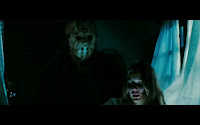 Conventionally low key lighting is used to create atmosphere and to play on the almost universal fear of the dark. With the exception of a few shots, my production was entirely filmed in well lit locations. This was not an artistic decision however but was due to the lack of lighting equipment. Luckily I feel this has not subtracted too much from my production but next time I would like to experiment with the lighting and try to incorporate lighting techniques into my production.
Conventionally low key lighting is used to create atmosphere and to play on the almost universal fear of the dark. With the exception of a few shots, my production was entirely filmed in well lit locations. This was not an artistic decision however but was due to the lack of lighting equipment. Luckily I feel this has not subtracted too much from my production but next time I would like to experiment with the lighting and try to incorporate lighting techniques into my production.
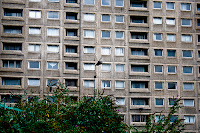 The dialogue of the main victim contains a lot of colloquialisms and it is evident that he is from an urban area of London. This challenges the conventions of real media products as usually the characters in slasher films are relatively well spoken which may be as it is easier to sympathize with someone who is well spoken or to represent the target audience. Another point that can be made from this is that not many slasher films are filmed in urban areas of London or contain characters from urban areas of London.
The dialogue of the main victim contains a lot of colloquialisms and it is evident that he is from an urban area of London. This challenges the conventions of real media products as usually the characters in slasher films are relatively well spoken which may be as it is easier to sympathize with someone who is well spoken or to represent the target audience. Another point that can be made from this is that not many slasher films are filmed in urban areas of London or contain characters from urban areas of London.
As my product is largely conventional and has been heavily inspired by previous slasher films, I decided to challenge certain conventions in order to give my product some originality.
My product challenges the forms and conventions of real media products in several ways. First, the victims in slasher movies are typically young, attractive, white women whereas in my production both victims are young black men (This does however use the slightly comical horror convention that the black guy always dies first).
 Conventionally low key lighting is used to create atmosphere and to play on the almost universal fear of the dark. With the exception of a few shots, my production was entirely filmed in well lit locations. This was not an artistic decision however but was due to the lack of lighting equipment. Luckily I feel this has not subtracted too much from my production but next time I would like to experiment with the lighting and try to incorporate lighting techniques into my production.
Conventionally low key lighting is used to create atmosphere and to play on the almost universal fear of the dark. With the exception of a few shots, my production was entirely filmed in well lit locations. This was not an artistic decision however but was due to the lack of lighting equipment. Luckily I feel this has not subtracted too much from my production but next time I would like to experiment with the lighting and try to incorporate lighting techniques into my production. The dialogue of the main victim contains a lot of colloquialisms and it is evident that he is from an urban area of London. This challenges the conventions of real media products as usually the characters in slasher films are relatively well spoken which may be as it is easier to sympathize with someone who is well spoken or to represent the target audience. Another point that can be made from this is that not many slasher films are filmed in urban areas of London or contain characters from urban areas of London.
The dialogue of the main victim contains a lot of colloquialisms and it is evident that he is from an urban area of London. This challenges the conventions of real media products as usually the characters in slasher films are relatively well spoken which may be as it is easier to sympathize with someone who is well spoken or to represent the target audience. Another point that can be made from this is that not many slasher films are filmed in urban areas of London or contain characters from urban areas of London. How does your media product represent particular social groups?
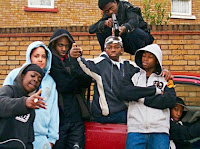 One of the social groups represented in my production are young black men. The media in general tends to portray young black men in a negative light as gangsters and thugs, especially those from London and other urban areas. In my production this stereotype has been subverted as the young black men in my opening sequence are the victims and not the aggressors. They are also both computer geeks and one is seen playing Xbox360 online and acting in a geeky fashion. This is not a stereotypical representation as young black men in general are portrayed by the media as 'cool' and hyper-masculine (so might not spend their time playing computer games).
One of the social groups represented in my production are young black men. The media in general tends to portray young black men in a negative light as gangsters and thugs, especially those from London and other urban areas. In my production this stereotype has been subverted as the young black men in my opening sequence are the victims and not the aggressors. They are also both computer geeks and one is seen playing Xbox360 online and acting in a geeky fashion. This is not a stereotypical representation as young black men in general are portrayed by the media as 'cool' and hyper-masculine (so might not spend their time playing computer games). Another social group represented in my production are those that play computer games (in particular those that play computer games online). In my production they are represented as competitive, immature and verbally abusive which I chose to do based on my own experiences playing online. I should add that this representation is based on a small minority of players I encountered as most people online communicate in a civil manner. Interestingly, the verbal abuse (usually of a homophobic or racial nature) on games such as Call of Duty:Black Ops has started to attract the attention of the media; "when my attention to online gaming shifted from the PC to the home console, I began to notice a comparatively more hostile environment. For whatever reason, this hostility usually came in the form of racial insensitivity and homophobic behavior" (An article on the website http://news.cnet.com/8301-17938_105-10400948-1.html).
Another social group represented in my production are those that play computer games (in particular those that play computer games online). In my production they are represented as competitive, immature and verbally abusive which I chose to do based on my own experiences playing online. I should add that this representation is based on a small minority of players I encountered as most people online communicate in a civil manner. Interestingly, the verbal abuse (usually of a homophobic or racial nature) on games such as Call of Duty:Black Ops has started to attract the attention of the media; "when my attention to online gaming shifted from the PC to the home console, I began to notice a comparatively more hostile environment. For whatever reason, this hostility usually came in the form of racial insensitivity and homophobic behavior" (An article on the website http://news.cnet.com/8301-17938_105-10400948-1.html). What kind of media institution might distribute your media product and why?
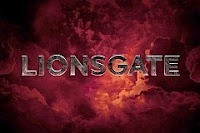 I believe the media institution that might distribute my media product would be Lionsgate. Lionsgate have a tradition of taking low budget horror films (Saw, Hostel, The Descent) and making them commercially successful which could be replicated with my production. What would interest them about my product is the fact that the ideas have already been formulated and the production has been completed so all that would be required of them is investment and the use of their resources (marketing, advertising e.t.c). Steve Beeks (President of Lionsgate) recently said “These are all titles that appeal primarily to the same demographic.....There is high coincidence of computer geeks that like horror films or action adventure movies.” As my movie is targeted at those with lifestyles that could be described as "computer geeks" and the story itself is based around computer geeks I believe this will interest Lionsgate further as they have extensive experience with distributing products similar to mine to audiences identical to those I have targeted.
I believe the media institution that might distribute my media product would be Lionsgate. Lionsgate have a tradition of taking low budget horror films (Saw, Hostel, The Descent) and making them commercially successful which could be replicated with my production. What would interest them about my product is the fact that the ideas have already been formulated and the production has been completed so all that would be required of them is investment and the use of their resources (marketing, advertising e.t.c). Steve Beeks (President of Lionsgate) recently said “These are all titles that appeal primarily to the same demographic.....There is high coincidence of computer geeks that like horror films or action adventure movies.” As my movie is targeted at those with lifestyles that could be described as "computer geeks" and the story itself is based around computer geeks I believe this will interest Lionsgate further as they have extensive experience with distributing products similar to mine to audiences identical to those I have targeted.Who would be the target audience for my product?
White/Male/18-24/Working Class/
I still believe my product is targeted at this audience however I feel with the inclusion of 2 black actors that perhaps the appeal will broaden by now attracting a larger percent of young black people.
How did you attract/address your audience?
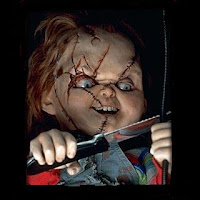 Usually, in order for a slasher film to be successful, it must have a unique selling point that makes it stand apart from other films in the sub-genre (Freddy Krueger can kill people in their dreams, Chucky is a killer doll, scream parodied the codes and conventions of the genre). Although my film borrows heavily from others I feel the concept of my story and the way in which the killer behaves gives my production a unique feel which could attract audiences. The fact that my production is filmed and set in London might also attract audiences as usually slasher films are set somewhere in america so my product offers audiences something different. As I said earlier the slasher sub-genre is a good example of genre purism as films of this genre have not changed much since the earliest slasher films. The themes that were prevalent from Halloween (which is regarded as the first true slasher) are still dominant now; male upon female voyeurism, murder, the inability of authority figures to deal with the threat, gender confusion and sexual perversion e.t.c. are still dominant now. This meant that in order to address my audience I had to satisfy the thrill they get from watching slasher films (being frightened, seeing graphic violence e.t.c.) by giving them the themes, codes and conventions (an indomitable and nefarious killer, people of the audiences age group being preyed upon e.t.c.) they expected to see and what similar audiences have been seing through the last couple of decades.
Usually, in order for a slasher film to be successful, it must have a unique selling point that makes it stand apart from other films in the sub-genre (Freddy Krueger can kill people in their dreams, Chucky is a killer doll, scream parodied the codes and conventions of the genre). Although my film borrows heavily from others I feel the concept of my story and the way in which the killer behaves gives my production a unique feel which could attract audiences. The fact that my production is filmed and set in London might also attract audiences as usually slasher films are set somewhere in america so my product offers audiences something different. As I said earlier the slasher sub-genre is a good example of genre purism as films of this genre have not changed much since the earliest slasher films. The themes that were prevalent from Halloween (which is regarded as the first true slasher) are still dominant now; male upon female voyeurism, murder, the inability of authority figures to deal with the threat, gender confusion and sexual perversion e.t.c. are still dominant now. This meant that in order to address my audience I had to satisfy the thrill they get from watching slasher films (being frightened, seeing graphic violence e.t.c.) by giving them the themes, codes and conventions (an indomitable and nefarious killer, people of the audiences age group being preyed upon e.t.c.) they expected to see and what similar audiences have been seing through the last couple of decades. 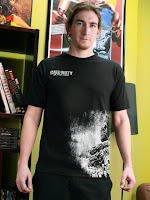 Specific ways in which I addressed my audience include choosing a title song by a band that the target audience probably listen to (Them Crooked Vultures). The concept of my story is about a killer who kills people who play online computer games (console games) which couldn't be more targeted at my audience as they themselves play computer games. This was further addressed by footage of the game Call of Duty: Black Ops. This game is the most played online game (for consoles) in the world and one in which the target audience will immediately recognise. As I stated earlier, Steve Beeks (president of Lionsgate) recently said "There is high coincidence of computer geeks that like horror films" which shows that adding computer games is a very effective way of targeting my audience.
Specific ways in which I addressed my audience include choosing a title song by a band that the target audience probably listen to (Them Crooked Vultures). The concept of my story is about a killer who kills people who play online computer games (console games) which couldn't be more targeted at my audience as they themselves play computer games. This was further addressed by footage of the game Call of Duty: Black Ops. This game is the most played online game (for consoles) in the world and one in which the target audience will immediately recognise. As I stated earlier, Steve Beeks (president of Lionsgate) recently said "There is high coincidence of computer geeks that like horror films" which shows that adding computer games is a very effective way of targeting my audience. What have you learnt about technologies from the constructing this product?
From the Preliminary task to the final product I have used a variety of technologies:
Preliminary Task
In this stage of the course I gained experience using a video camera and a tripod. The camera I used was a Panasonic NV-GS320 Mini-DV and the tripod I used was a Slik D3. From this task I learnt the basic controls of the camera including the locations of the record button, zoom function, and also how to switch between record mode and playback mode. I learnt about the type of tape this camera uses and how to insert one into the camera. I learnt how to assemble the tripod, attach the camera to the tripod and also how to position the tripod to create a certain shot type.
Planning/Pre-Production
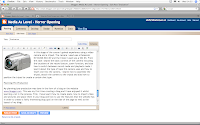 My planning/pre-production was done in the form of a blog on the website http://www.blogger.com/. This was the first time I have created a blog and I have enjoyed it whilst learning a lot in the process. I have learnt how to make posts, import videos and pictures and place them onto your blog and also how to use some of the websites other functions(I made 2 polls on the side of my blog).
My planning/pre-production was done in the form of a blog on the website http://www.blogger.com/. This was the first time I have created a blog and I have enjoyed it whilst learning a lot in the process. I have learnt how to make posts, import videos and pictures and place them onto your blog and also how to use some of the websites other functions(I made 2 polls on the side of my blog). 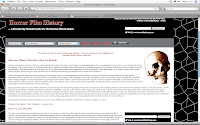 I used the internet a lot for research purposes during this stage to find out about the history of the horror genre, the codes and conventions of the slasher sub-genre, to find my target audience e.t.c. Sites that I used to do this include: http://www.horrorfilmhistory.com/ , http://www.cse.dmu.ac.uk/~p06280755/tech1015/cw/xhtml/slash_conven.html e.t.c. By doing this I learnt how the internet can be utilized to gather information and also how to navigate the websites listed.
I used the internet a lot for research purposes during this stage to find out about the history of the horror genre, the codes and conventions of the slasher sub-genre, to find my target audience e.t.c. Sites that I used to do this include: http://www.horrorfilmhistory.com/ , http://www.cse.dmu.ac.uk/~p06280755/tech1015/cw/xhtml/slash_conven.html e.t.c. By doing this I learnt how the internet can be utilized to gather information and also how to navigate the websites listed.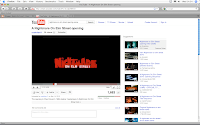 When researching similar texts I used youtube to watch the openings and then analyzed the codes and conventions. From this I learnt how youtube can also be a good source of information and is a good tool in order to add visual aids to your blog.
When researching similar texts I used youtube to watch the openings and then analyzed the codes and conventions. From this I learnt how youtube can also be a good source of information and is a good tool in order to add visual aids to your blog.Production
At this stage I gained further experience with both the camera and the tripod (I used the same equipment as I did in the preliminary task). Primarily I learnt about the limitations of both pieces of equipment in particular the camera. I learnt the cameras battery has a very small life which forced me to stop filming for 30minutes. This taught me to use the camera more sensibly and to make sure I have a charged battery spare just in case. The cameras default zoom is very annoying too as even without zooming in the camera feels too close to the action. This created many problems considering the room I filmed the majority of my scene in was very small and so limited the amount of shots I could use.This taught me in future to check the locations and equipment before the day of filming. Similarly the large tripod created problems as when fully extended it takes up a large portion of the room I filmed in.
In one part of my opening sequence, the victim sees the killer murder someone on his television. To create this effect I had to first film the killer with a different camera (similar to the one pictured) and then play it back on the tv using an AV cable. I then recorded the screen in a P.O.V shot for most of the part before zooming in to capture a key moment of the scene (when the killers mask is revealed). From this I learnt how the use of technology could be used to create certain effects and also how cameras can interact with televisons.
Post-Production
This is the stage of the construction process where I learnt the most about technologies.
First I learnt how to use the iMac G5 which is quite different to the pc I use at home. In the time that I have used it I have learnt how to access applications, shortcut keys (e.g. command-shift-3 on a iMac is the same as a PC's print screen button which I have used in my blog more than once), how to navigate menus and just the operating system in general. The fact that the media suite at my college is full of iMacs and not PCs tells me that perhaps the Macs are better for editing purposes.
I learnt how to import footage on a Mini-DV camera into an iMac using a firewire (This also taught me how large DV files are compared to DVD files as they are compressed to a lesser degree).
The footage was imported into an iMac application called iMovie (version 4) and this is where I edited it. I was expecting to be dissapointed with iMovie as I was told by friends that it is basic in comparison to other editing software such as FinalCut Pro but I enjoyed using it because of its simplicity. I learnt how to cut my footage and manipulate it so that my sequence looked exactly as I wanted it to and how to use the different time bars to arrange the different shots. I learnt how to change the audio levels and how to extract unwanted audio from my footage and delete it without deleting the video. I learnt how to add titles and effects such as slow motion which I used a couple of times in my production aswell as how to import other sounds and videos I downloaded from the internet.
The music I used was downloaded from a royalty free internet site called http://www.incompetech.com/. The sound effects I used were downloaded from a different site called http://www.soundbible.com/. Both were then imported into iMovie and then synchronized with my video.
The opening shots of a computer game required more effort to obtain. I had to browse youtube for the video I wanted to use. I then used a website which rips videos from youtube called http://www.keepvid.com/ and converts them into mp4 files. I then imported this file into iMovie and cut it before placing it in the sequence I wanted. This obviously taught me how to download videos from youtube and import them into iMovie.
Looking back at your preliminary task, what do you feel you have learnt in the progression from it to the full product?
The preliminary task was a very basic exercise but important, as it taught me how important it is to frame shots correctly, to have a still camera, how to use the cameras functions and also to obey the 180 degree rule in order to maintain verisimilitude. I learnt how to move the camera with the tripod and had the opportunity to practice the different shot types. All the things I learnt in the preliminary task were incorporated into my final product so it was very helpful for me.
From the preliminary task to the final product I feel I have learned how to successfully plan a production with regards to what mise-en-scene to use and why, how to identify the codes and conventions and then either use them or challenge them, how to edit raw footage to make it comprehensible and effective as an example of a specific sub-genre e.t.c. I feel I could have done the lighting in my production better and also arranged my actors better so I would not had to have changed my idea.
I think I have successfully created an opening sequence that is identifiable as a slasher and effective at delivering to the audience what they expect.
I believe my strengths are imagining what the sequence will look like and then using the equipment and technologies to make it a reality. I also believe that I have good organisation skills/work ethic considering I have completed all stages of production by myself.
I believe my weakness was not taking risks as right from the beginning I wanted to make a product that was ambitious and required other technology then those avaliable at the college but I ended up doing a simple idea.
From the preliminary task to the final product I feel I have learned how to successfully plan a production with regards to what mise-en-scene to use and why, how to identify the codes and conventions and then either use them or challenge them, how to edit raw footage to make it comprehensible and effective as an example of a specific sub-genre e.t.c. I feel I could have done the lighting in my production better and also arranged my actors better so I would not had to have changed my idea.
I think I have successfully created an opening sequence that is identifiable as a slasher and effective at delivering to the audience what they expect.
I believe my strengths are imagining what the sequence will look like and then using the equipment and technologies to make it a reality. I also believe that I have good organisation skills/work ethic considering I have completed all stages of production by myself.
I believe my weakness was not taking risks as right from the beginning I wanted to make a product that was ambitious and required other technology then those avaliable at the college but I ended up doing a simple idea.





No comments:
Post a Comment